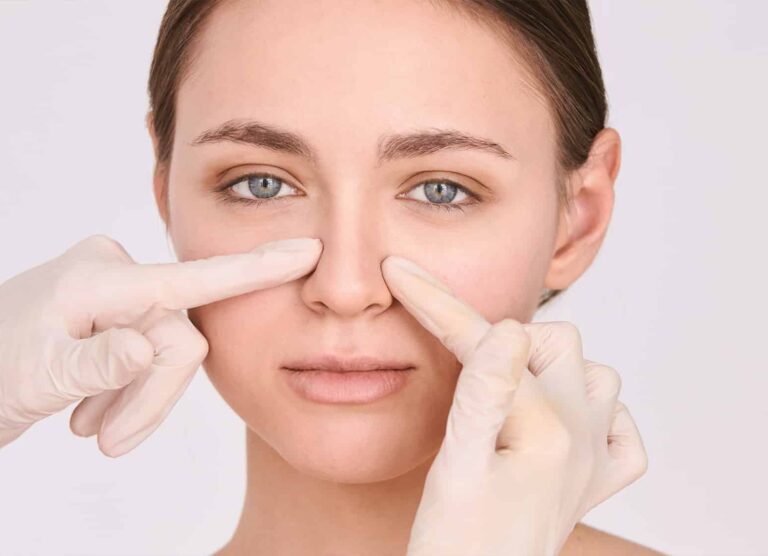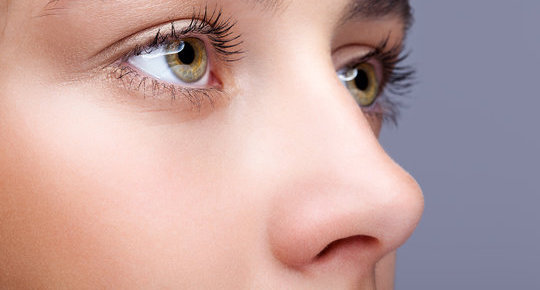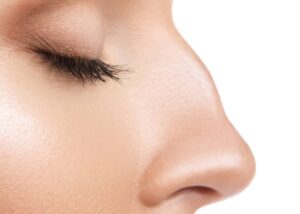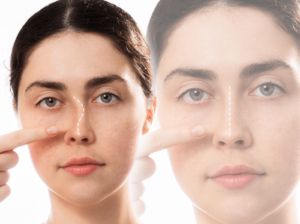Non-Surgical Rhinoplasty
What is non-surgical rhinoplasty, also known as liquid rhinoplasty?
Non-surgical rhinoplasty, also known as a non-surgical nose job or liquid rhinoplasty, is a procedure that uses injectable dermal fillers to alter the shape of the nose without the need for surgery. Non-surgical rhinoplasty corrects minor imperfections or asymmetries in the nose, adds volume to certain areas, or smooths bumps or depressions.
How does non-surgical rhinoplasty work?
The procedure uses a local anesthetia to numb the treated area.
The doctor will inject the filler into specific nose areas to achieve the desired shape.
Non-surgical rhinoplasty is a relatively quick procedure that can be performed in the doctor’s office, and the results are visible immediately.
Liquid Rhinoplasty is generally considered a safe and low-risk procedure.
However, there are some potential side effects and complications to be aware of, such as swelling, bruising, and infection.
The results of non-surgical rhinoplasty are not permanent, and the procedure must be repeated periodically to maintain the desired results.
What are the benefits of non-surgical rhinoplasty compared to surgical rhinoplasty?
Non-surgical rhinoplasty has several benefits compared to surgical rhinoplasty, including.
- Non-surgical rhinoplasty is a minimally invasive procedure that does not require any anaesthesia or surgery, which means that it has a lower risk of complications and a shorter recovery time.
- Non-surgical rhinoplasty can be performed in the doctor’s office in just a few minutes, making it a convenient option for people with busy schedules.
- Because it is a minimally invasive procedure, there is no need for recovery time or downtime. Most people can return to their normal activities immediately after the procedure.
- Liquid Rhinoplasty is generally less expensive than surgical rhinoplasty.
- The results of non-surgical rhinoplasty are not permanent, which means that the procedure can be easily reversed or modified if the patient is not satisfied with the results.
However, it’s important to note that non-surgical rhinoplasty is generally less effective at achieving significant changes in the shape or structure of the nose than surgical rhinoplasty. It may be suitable for making subtle improvements or maintaining results achieved through surgery, but it is not a good option for more extensive changes.
What can be done with a non-surgical nose job?
Non-surgical nose jobs, also known as liquid rhinoplasty or “nose fillers,” use injectable fillers to alter the shape of the nose. They can be used to:

- Correct small imperfections or asymmetries in the nose.

- Enhance the appearance of a bump on the nose.

- Lift the tip of the nose.

- Smooth out the appearance of a “hump” on the bridge of the nose.

- Straighten a crooked nose.
It is important to note that non-surgical nose jobs are only suitable for some, and they may not achieve the same results as surgical rhinoplasty. In addition, the effects of a non-surgical nose job are not permanent, and the procedure may need to be repeated to maintain the desired result.
Who is a good candidate for non-surgical rhinoplasty?
Non-surgical rhinoplasty may be a good option for people who want to make subtle improvements to the appearance of their noses without surgery. It may be suitable for correcting minor imperfections or asymmetries in the nose, adding volume to certain areas, or smoothing bumps or depressions.
In general, non-surgical rhinoplasty is most suitable for people with realistic expectations about what the procedure can achieve. It is not a good option for people looking to make significant changes to the shape or structure of their nose, as these changes are best achieved through surgical rhinoplasty.
To determine if non-surgical rhinoplasty is a good option, it is important to consult with a qualified surgeon who can assess your needs and goals and advise you on the best treatment options. The surgeon should also carefully review your medical history to ensure that you are a good candidate for the procedure.
How long does non-surgical rhinoplasty take?
Non-surgical rhinoplasty is a relatively quick procedure that can be performed in as little as 15-30 minutes, depending on the extent of the treatment and the patient’s specific goals. The procedure is performed in the doctor’s office, and most people can return to normal activities immediately after the procedure.
Is non-surgical rhinoplasty permanent?
- The results of non-surgical rhinoplasty are not permanent. It is a temporary treatment that uses injectable dermal fillers to alter the shape of the nose. The effects of the fillers will eventually wear off, and the nose will return to its original shape.
- The time period the results of non-surgical rhinoplasty last will vary depending on the specific filler used and the individual’s metabolism. In general, the results of non-surgical rhinoplasty can last anywhere from several months to over a year. To maintain the desired results, patients must repeat the procedure periodically.
- It’s important to note that non-surgical rhinoplasty is generally less effective at achieving significant changes in the shape or structure of the nose than surgical rhinoplasty. It may be suitable for making subtle improvements or maintaining results achieved through surgery, but it is not a good option for more extensive changes.
Other Treatment options for Non-surgical rhinoplasty:
- Dermal fillers, such as hyaluronic acid fillers, can add volume and shape to the nose.
- Silicone can be injected into the nose to alter its shape, but this is not a safe or recommended procedure due to the potential for serious complications.
- Radiofrequency treatment can be used to tighten and lift the skin on the nose.
- Thread lifts involve using small, absorbable threads to lift and tighten the skin on the nose.
- Laser resurfacing can smooth out imperfections and improve the overall texture and appearance of the skin on the nose.
Can non-surgical rhinoplasty be combined with other rejuvenation treatments?
Yes, non-surgical rhinoplasty can be combined with other facial treatments to achieve a more comprehensive or balanced improvement in the appearance of the face. For example, non-surgical rhinoplasty can be combined with dermal fillers or other injectables to enhance other facial features, such as the cheeks or lips. It can also be combined with skin rejuvenation treatments such as laser resurfacing or chemical peels to improve the overall texture and appearance of the skin.
Combining non-surgical rhinoplasty with other treatments can be a convenient way to achieve a more comprehensive improvement in the appearance of the face. It can also help create a more natural-looking result. However, it’s important to carefully consider the potential risks and benefits of combining treatments and the potential impact on the overall cost of the procedure.
Suppose you are interested in combining non-surgical rhinoplasty with other facial treatments. In that case, it is important to discuss your options with a qualified cosmetic surgeon who can assess your individual needs and goals and advise you on the best course of treatment.
IS LIQUID RHINOPLASTY WORTH IT?
Liquid rhinoplasty, also known as non-surgical rhinoplasty or “nose fillers,” is a cosmetic procedure that uses injectable fillers to alter the shape of the nose. It can be a good option for people looking to make subtle changes to the appearance of their noses without undergoing surgery.
There are a few potential benefits of liquid rhinoplasty:
- It is less expensive than surgical rhinoplasty.
- It has a shorter recovery time.
- It is less invasive than surgical rhinoplasty.
- It can be reversed if you are not satisfied with the results.
However, it is important to keep in mind that the results of liquid rhinoplasty are not permanent, and the procedure may need to be repeated to maintain the desired effect. In addition, liquid rhinoplasty may not be suitable for people who are looking to make significant changes to the shape of their nose or who have certain medical conditions.
Overall, whether or not liquid rhinoplasty is worth it will depend on your individual goals and circumstances. It is important to discuss your options with a qualified plastic surgeon or dermatologist before deciding which treatment is right for you.
Risks or side effects of non-surgical rhinoplasty?
As with any medical procedure, there are potential risks and side effects associated with non-surgical rhinoplasty. Some possible risks and side effects include:
- Non-surgical rhinoplasty may cause swelling in the treated area, which can last for several days or weeks.
- Non-surgical rhinoplasty may cause bruising, which can take several days or weeks to resolve.
- There is a small risk of infection associated with any procedure that involves injecting a foreign substance into the body.
- Some people may be allergic to the dermal filler used in non-surgical rhinoplasty.
- Non-surgical rhinoplasty may result in asymmetry or unevenness in the treated area.
- Some people may be dissatisfied with the results of non-surgical rhinoplasty, either because the changes need to be more significant or because the desired results are not achieved.
It’s important to discuss the potential risks and side effects of non-surgical rhinoplasty with the cosmetic surgeon before the procedure so that you can make an informed decision about whether it is the right choice for you. The surgeon should also provide instructions on managing any potential side effects or complications that may arise after the procedure.
FAQ
- Non-surgical rhinoplasty uses an anaesthesia to numb the area being treated. Some people may experience slight discomfort during the injection, but this should be minimal and subside quickly.
- After the procedure, some may experience mild swelling, tenderness, or soreness in the treated area, but these effects are usually mild and should resolve within a few days. The surgeon will provide instructions on how to manage any post-procedure discomfort.
- Overall, non-surgical rhinoplasty is a relatively painless and well-tolerated procedure. However, everyone’s pain tolerance is different, and some people may experience more discomfort than others. If you are concerned about pain, it’s important to discuss these with your surgeon before the procedure so that they can take steps to ensure your comfort.
- The results of non-surgical rhinoplasty are visible immediately after the procedure. However, it is common for the treated area to be swollen or bruised for a few days after the procedure, which can make the final results difficult to see.
- It usually takes several days or weeks for the swelling and bruising to resolve, after which the final results of the procedure should be visible. Some people may notice additional changes in the shape of their noses as the filler settles into place over the course of several weeks.
- In general, the results of non-surgical rhinoplasty can last anywhere from several months to over a year. To maintain the desired results, patients must repeat the procedure periodically.
- It’s important to remember that non-surgical rhinoplasty is generally less effective at achieving significant changes in the shape or structure of the nose than surgical rhinoplasty. It may be suitable for making subtle improvements or maintaining results achieved through surgery, but it is not a good option for more extensive changes.
- Yes, non-surgical rhinoplasty can be combined with other facial treatments to achieve a more comprehensive or balanced improvement in the appearance of the face. For example, non-surgical rhinoplasty can be combined with dermal fillers or other injectables to enhance other facial features, such as the cheeks or lips. It can also be combined with skin rejuvenation treatments such as laser resurfacing or chemical peels to improve the overall texture and appearance of the skin.
Combining non-surgical rhinoplasty with other treatments can be a convenient way to achieve a more comprehensive improvement in the appearance of the face. It can also help create a more natural-looking result. However, it’s important to carefully consider the potential risks and benefits of combining treatments and the potential impact on the overall cost of the procedure.
Suppose you are interested in combining non-surgical rhinoplasty with other facial treatments. In that case, it is important to discuss your options with a qualified cosmetic surgeon who can assess your individual needs and goals and advise you on the best course of treatment.
- The cost of non-surgical rhinoplasty varies depending on several factors, including the type and amount of dermal filler used, the complexity of the procedure, the doctor’s experience and reputation, and the geographic location of the practice. In general, non-surgical rhinoplasty is less expensive than surgical rhinoplasty.
- However, this is a rough estimate, and the actual cost of the procedure may be higher or lower depending on the specific factors mentioned above. It ranges from 25,000 to 1.5 lacs based on the various factors mentioned.
- It’s important to remember that non-surgical rhinoplasty is a temporary treatment that will need to be repeated periodically to maintain the desired results. This can add to the overall cost of the procedure over time.
- If you are considering non-surgical rhinoplasty, it’s important to discuss the cost of the procedure with your surgeon before the treatment is performed. They should be able to provide you with an estimate of the total cost and information about any financing options that may be available.
